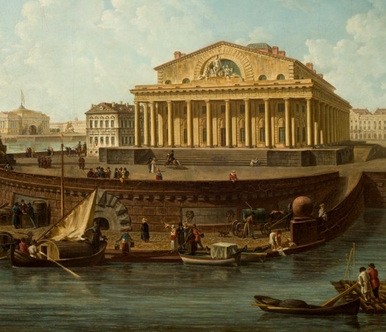The ‘Guriev service’ is an example of the Empire style in Russian porcelain. Working on the service started in 1809. Originally it was called the ‘Service with the Russian Costumes’ Images’, or the “Russian Service”, as the main idea for its decorative part was the depiction of different scenes from the life of the Russian society and glorification of the Russian Empire territory. The service which included dinner, dessert and tea sets primarily consisted of 900 objects. All of them had pictures with the scenes of Russian society’s life. The views of Saint Petersburg from the paintings and engravings of Russian and foreign painters were chosen for the pictorial decoration. The illustrations from the books ‘People of Russia’ and ‘Scenes and archetypes of Saint Petersburg’ were used as well. Some scenes from the peasants’ life, “borrowed” from Venetsianov’s works, illustrated a number of porcelain objects.
Starting from 1824, the service was named ‘Guriev’ after Count Dmitry Aleksandrovich Guriev. At the time count was curating the Imperial Porcelain Factory. Stepan Pimenov, a model-maker and an associated professor of the Imperial Academy of Arts (1809-1916) was engaged into developing the models for the dishes. In 1809-1830 he was in charge of the sculptural department of the Imperial Porcelain Factory. It was him who put into practice usage of sculptural forms for decorating the bowls, vases and other elements of table decoration.
In the big services the dessert bowls with the sculptured pedestal play the role of table composition’s centre. The body of a featured bowl is a figure of a standing peasant with a fruit bowl. Looking into his face, one may find clear parallels with the Antique originals, this is the way the Greek young men were depicted. The Empire style tends towards formality and theatricalism. This is the style of the emperors. In its artistic basis the Empire was based on the Greek and Roman heritage. The Empire style ceremonial dishes were always full of golden decoration. In early 19th century fire gilding was often used in Russia. The paste made of mercury and gold was applied to the porcelain and then heated. Under the influence of temperature mercury evaporated and gold was getting tightly fixed at the object’s surface. Such work was very bad for health, as the mercury vapor is poisonous, so the gilders’ job was highly valued.
For a long time porcelain was considered to be a “white gold”, and its price was comparable with the pieces of jewelry. Such services were ceremonial and were only used on the occasion of the celebrations and special events. The “Guriev service” was commissioned for usage in the Winter Palace and later was moved to Peterhof.
Afterwards the new objects were added to it many times, and by the accession of Nicolas II the number of objects increased to four and a half thousand. At the same time the new variations of its color schemes appeared, the gold started to be combined not only with the terra cotta, but also with the green elements.
Starting from 1824, the service was named ‘Guriev’ after Count Dmitry Aleksandrovich Guriev. At the time count was curating the Imperial Porcelain Factory. Stepan Pimenov, a model-maker and an associated professor of the Imperial Academy of Arts (1809-1916) was engaged into developing the models for the dishes. In 1809-1830 he was in charge of the sculptural department of the Imperial Porcelain Factory. It was him who put into practice usage of sculptural forms for decorating the bowls, vases and other elements of table decoration.
In the big services the dessert bowls with the sculptured pedestal play the role of table composition’s centre. The body of a featured bowl is a figure of a standing peasant with a fruit bowl. Looking into his face, one may find clear parallels with the Antique originals, this is the way the Greek young men were depicted. The Empire style tends towards formality and theatricalism. This is the style of the emperors. In its artistic basis the Empire was based on the Greek and Roman heritage. The Empire style ceremonial dishes were always full of golden decoration. In early 19th century fire gilding was often used in Russia. The paste made of mercury and gold was applied to the porcelain and then heated. Under the influence of temperature mercury evaporated and gold was getting tightly fixed at the object’s surface. Such work was very bad for health, as the mercury vapor is poisonous, so the gilders’ job was highly valued.
For a long time porcelain was considered to be a “white gold”, and its price was comparable with the pieces of jewelry. Such services were ceremonial and were only used on the occasion of the celebrations and special events. The “Guriev service” was commissioned for usage in the Winter Palace and later was moved to Peterhof.
Afterwards the new objects were added to it many times, and by the accession of Nicolas II the number of objects increased to four and a half thousand. At the same time the new variations of its color schemes appeared, the gold started to be combined not only with the terra cotta, but also with the green elements.

